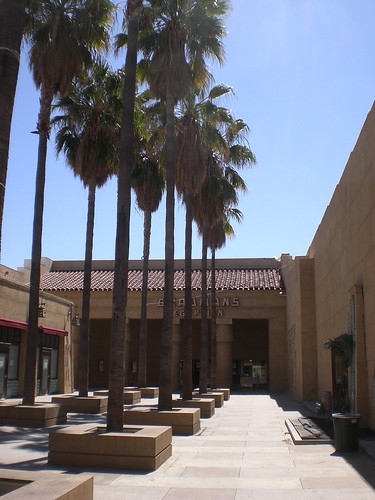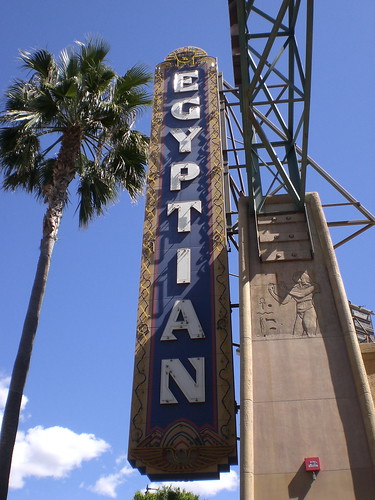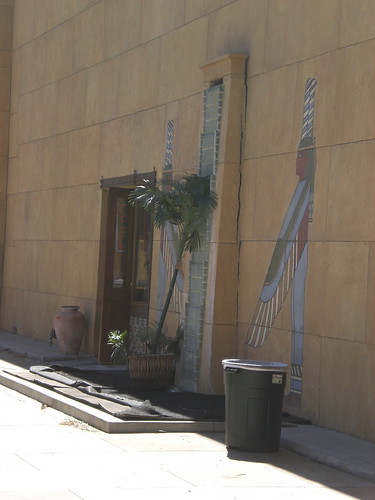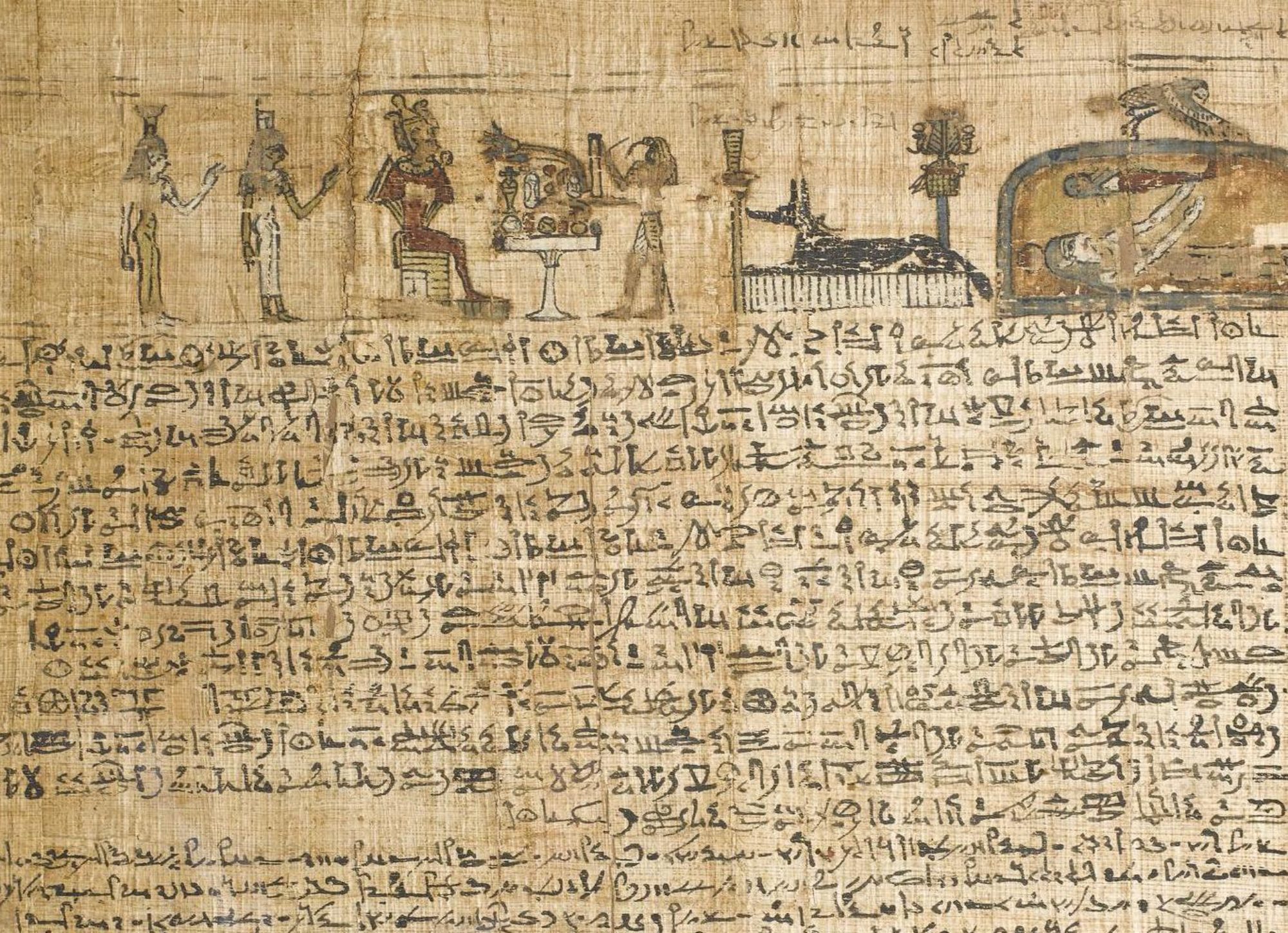As an Egyptologist, I understand from first-hand experience how captivating Egyptian culture can be, and I find it interesting to contemplate the ways in which Egyptomania seized upon the minds and imaginations of people in the 19th and early 20th centuries and manifested itself in art, architecture, and advertising ranging from the absurd to the sublime. It spread throughout the Western world and beyond, from Europe and North America to Russia and South Africa. There are certainly numerous examples of the craze in London (see my Egyptological map of the city), but some other interesting examples have been featured on the internet lately.
Bonhams’s recently had an Egyptian Revival sale and the pieces that were auctioned can all be viewed on the site here. Some wonderful pieces are actually directly inspired by real Egyptian artifacts, for example this chair modelled on the chair of Sitamun from the tomb of Yuya and Tuya as pictured here, while others provide comedy value with their extravagant over-blown design and heavy-handed interpretations of Egyptian design that bear little resemblance to their supposed origins.
I also stumbled across a very interesting article, purely by chance, mainly about the Egyptian-inspired movie theatres of the United States but also touching on the history of Egyptomania itself. The entire article by Bruce Handy of Vanity Fair is well-worth reading, but the most gripping description is perhaps that of Grauman’s Egyptian Theater and its spectacular role in the very first ever movie premiere. Back in 1922, before the discovery of Tutankhamun’s tomb, when Hollywood was just a sleepy stretch of orchards dotted with a few fledgling movie studios and the joke was that ‘cannonball could be fired down Hollywood Boulevard any time after nine at night and never hit a soul’, it was decided that a movie theatre would be ‘the perfect anchor for commercial development. And not just any movie theater: it would be one of the most spectacular the world had ever seen’.
As Handy states:
‘On October 18, 1922, with newspaper ads promising that “every star and director in the motion picture industry will be there,†Grauman’s Egyptian Theatre was unveiled in all its pharaonic splendor, playing host to the world premiere of Douglas Fairbanks’s Robin Hood.

Grauman’s Egyptian Theatre. Photo by Steve Minor
It was a hell of an evening. The newly installed Hollywood Egyptian Theatre Symphony Orchestra played the overture from Aida. Speeches were given by Charlie Chaplin, Cecil B. DeMille, Jesse Lasky (one of the founders of the studio that would become Paramount Pictures), and the mayor of Los Angeles. Fairbanks, of course, was in attendance, as was his wife, Mary Pickford, along with John Barrymore and the Talmadge sisters, all of whom had strode down a long red carpet, which had been laid over the theater’s extended courtyard and was flanked by crowds of gawkers and photographers. It was, literally, the original Hollywood premiere. “First night audience rivals Paris in styles”, bragged one Los Angeles paper. “Greatest gathering of kind in Hollywood history”, trumpeted another, describing “a jam of people and motor cars … extending in all directions†while “the picture stars were wildly greeted†and numerous photos taken of the “kaleidoscopic human spectacle.â€
The theater was its own kind of kaleidoscope, a riot of hieroglyphs and cenotaphs, animal-headed gods and winged scarabs, bas-relief sphinx heads and a gilded sun-disk ceiling. Even the bathrooms featured what one critic described as “fascinating Egyptian decorations done in the soft reds, blues, and yellows in which this early nation delighted.†The screen itself, one of the interior’s few unadorned surfaces, was framed by four pillars, decorated like papyrus plants and topped by a pair of massive, heavy-looking lintels seemingly awaiting only the fulfillment of an ancient mummy’s curse to tumble down and seal the auditorium in the dust and gloom of millennia. Earlier theaters had had Egyptian elements, but this was ancient Egypt given the full, unabashed Hollywood treatment…
Art and Archaeology declared in 1924 that Grauman’s Egyptian “is not made up of grotesque statues, sphinxes, pyramids, and meaningless signs in lieu of hieroglyphics, but is a replica of real Egyptian art and architecture.â€
For a second opinion, [Bruce Handy] asked Richard A. Fazzini, an Egyptologist at the Brooklyn Museum who is also a passionate scholar of Egyptomania, to look at photos of various Egyptian theaters, including Grauman’s. He praised the accuracy of many of that theater’s “playful†design elements, but noted, “Nothing in Egypt ever looked like that as a whole.†He pointed to the decoration of the theater’s massive lintel: “A winged scarab flanked by what—swans? No, that doesn’t work. A winged scarab maybe, but not flanked by swans. I don’t know if they had swans in Egypt, but they didn’t appear in the art really”.’
Grauman’s ignited a vogue for Egyptian-themed theaters in America and in the 1920s some four dozen were built ‘bringing the glories of the Nile to exotica-poor locales such as Brooklyn, Denver, Seattle, Indianapolis, Houston, Milwaukee, and Ogden, Utah’.
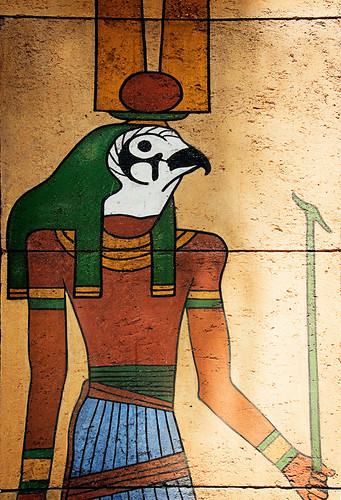
Detail from Grauman’s Egyptian Theatre. Photo by Steve Minor
But why did the movie industry in particular seize upon Egyptomania so enthusiastically? The main reason is the obvious coincidence of timing between the discovery of Tutankhamun’s tomb and the birth of cinema. As Handy notes: ‘Of negligible import as a pharaoh, Tut nevertheless enjoys one of the ancient world’s highest Q ratings, right up there with Jesus, Mary, Cleopatra, and the first two Caesars. The discovery also unleashed one of the West’s greatest waves of Egyptomania… Filmmakers, then as now not immune to popular taste, released Tut-ankh-Amen’s Eighth Wife and Tut-Tut and His Terrible Tomb, both in 1923. Tin Pan Alley staked its own claim with “Old King Tut Was a Wise Old Nut.‒ However, I think there were several other reasons why Egyptian design became so popular a style for movie theatres and they lie in the nature of the movie industry at the time, how Egypt was perceived and what it represented to people.
Movies were a way of transporting people, allowing them to use their imaginations and escape. Ancient Egypt had already been a popular subject for early filmmakers with five features about Cleopatra alone made between 1908 and 1918. Ancient Egypt was exotic and mysterious; by designing theatres in Egyptian styles, the cinemas themselves became fuel for the imagination, pure escapism in architecture. With cinema in its early stages, studios and theatres wanted to convince people of the industry’s stability and potential for success and longevity. What better association to make than with the eternal land of pyramids and temples? Also, the image Hollywood has always cultivated for itself is one of opulence, and it seems hardly coincidence that the first glamorous red carpet parade happened at the opening of Grauman’s Egyptian Theater, with its rich Egyptian style decor suggesting all the golden wealth of the ancient civilization that Hollywood wished to emulate. Using the motifs of Egyptian design was more than just an architectural fad, they could be used to convey a message to audiences and contribute to the image Hollywood studios wished to present.
Handy also discusses why Egyptian themes were so popular with early America as a nation:
‘Nineteenth-century America clasped ancient Egypt especially close to her bosom. “The Egyptian style,†writes the historian Blanche Linden-Ward, “captured the imagination of arbiters of American culture intent on finding new symbols representative of their nation. Many Americans in the 1830s equated their country with Egypt, another ‘first civilization’ … They nicknamed the Mississippi the ‘American Nile’ and gave the names of Memphis, Cairo, Karnak and Thebes to new towns along its banks.†Perhaps the most famous example of our forebears’ Egyptophilia, aside from the Great Seal, is the Washington Monument, a 555-foot-tall obelisk that was designed in 1836 (though not completed until 1884). Another proposed monument, serious enough to be entertained by Congress, would have entombed the father of his country pharaoh-style in a giant pyramid, which demonstrates the pitfalls of modeling a fledgling republic after a millennia-old monarchy, at least when it comes to questions of official taste.’
Although Washington didn’t get a pyramid from Congress, according to theater historian David Naylor, the flamboyant movie exhibitor Grauman gave him an even more bizarre memorial in his second downtown theatre, the Metropolitan: ‘a sphinx with the head of George Washington on a pedestal beside the lobby staircase. The quote near the base of the sphinx read, “You cannot speak to us, O George Washington, but you can speak to God. Ask him to make us good American citizens”‘.
Although Grauman’s Egyptian Theater has been restored and is currently the home of the American Cinematheque, of the 40 to 50 Egyptian theatres built in America in the 1920s, only a handful survive.
The sad thing I find is that I can no longer imagine an Egyptian revival of such magnitude ever taking place again, or at least not one that would be taken seriously and valued for the elegance and energy of its design. The media, movie-industry, and disappointingly even the way Egypt and its treasures are promoted, have all contributed to some people’s view of Egypt not just as a stereotyped land of gold and mummies, but have also added tacky, over-the-top, crude, and laughable overtones to the way it’s perceived. Sadly some of the crasser examples of Egyptomania can also be said to have contributed. Despite the general public’s fascination with Egypt, their exposure is superficial, with few people able to tell the difference between crude inaccurate Egyptian-style reproductions and the real artistry of the originals.
As the author of the aforementioned article, Bruce Handy, similarly notes:
‘Most of us have gleaned whatever knowledge we have of ancient Egypt from popular culture, whether Boris Karloff’s The Mummy, Elizabeth Taylor’s Cleopatra, Victor Buono’s King Tut on the old Batman show, Steve Martin’s novelty song “King Tut†(in which the boy king moves from Arizona to Babylonia, where he owns a “condo made of stone-aâ€), or Brendan Fraser’s frantic Mummy remakes. Indeed, judging from these sources, you’d be forgiven for thinking that ancient Egypt’s was the silliest civilization that ever existed’.
None of this is going to be changed anytime soon, if Egypt continues to be presented in a way that aims to appeal to the lowest common denominator with sensationalism rather than aspiring to a more informed representation. Commercialism feeds people’s misconceptions of Egyptian culture in an attempt to cash in and sadly one of the most disappointing examples of this happening is connected to what should be an opportunity to educate people.
I think the marketing for the Tutankhamun exhibit at the O2 buys too much into stereotypes, trying to sell it on gold, gold, and more gold, and raising false hopes of seeing the famous death mask, rather than helping people see that viewing more domestic objects can actually give us more insight into the life of the boy king. I’ve even heard that the gift shop features a tissue box in the form of the famous mask, where the tissues come out of the nostrils! But I shouldn’t really judge until I’ve seen it myself. I’m planning to visit it at the end of March, and when I do I’ll let you know what I think of it.
I believe that it’s possible to harness the interest in Egypt inspired by Hollywood and the media, and use it as an opportunity to introduce people to the real Egypt. Though exciting action and glittering gold can glamorize Egypt, it remains that this fascinating culture has intrigued people since ancient Greek and Roman times and will continue to in spite of the misleading publicity it gets. For those willing to actually take a close look at the objects and monuments or read about them will realize that it can be even more thrilling to pierce the veil of mystery that shrouds the *real* Egypt and to delve into the lives of the people who created this astounding civilization.
For further reading on Egyptomania, I can recommend Imhotep Today: Egyptianizing Architecture, a nice collection of essays on examples from around the world.
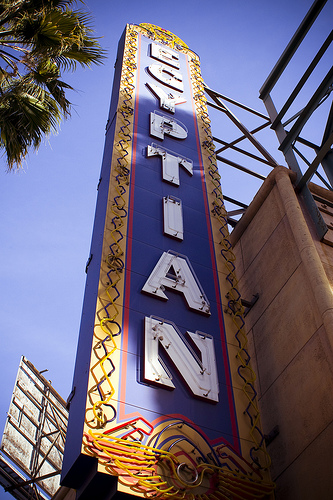
Sign for Grauman’s Egyptian Theatre. Photo by Kevin Stanchfield.

